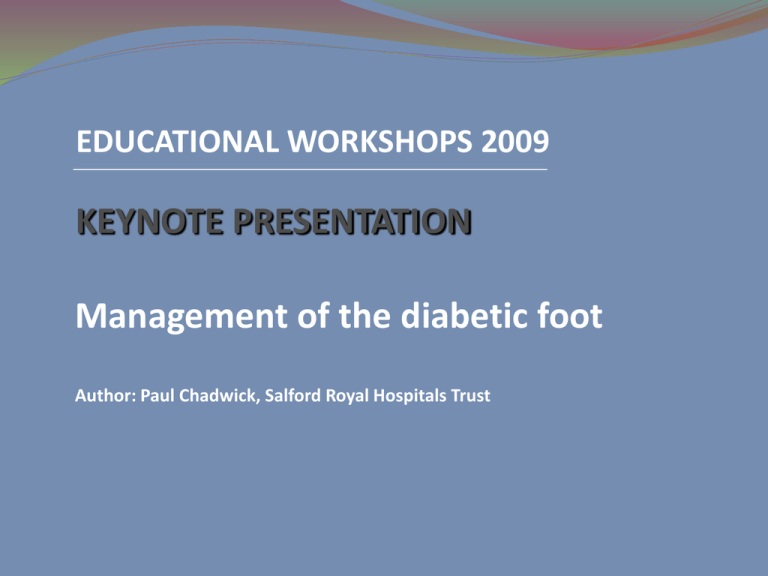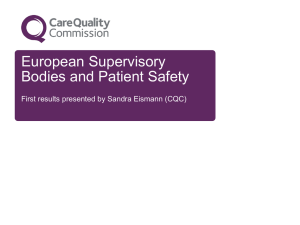Keynote Lecture
advertisement

EDUCATIONAL WORKSHOPS 2009 KEYNOTE PRESENTATION Management of the diabetic foot Author: Paul Chadwick, Salford Royal Hospitals Trust Sponsored through an unrestricted educational grant from Novartis Pharmaceutical Ltd to help support the cost of developing and hosting this educational workshop series Case History A 76 year old man was admitted as an emergency with a red and swollen right foot Apyrexial and haemodynamically stable Diagnosed with type 2 diabetes two years earlier Oral hypoglycaemic therapy: blood sugar control moderate Author: Paul Chadwick, Salford Royal Hospitals Trust Investigations X-ray of the foot showed changes consistent with both osteomyelitis and soft tissue infection C-reactive protein 219 mg/l (<10mg/l) Neutrophils 19.2 x109/l (4-11 x109/l) Plasma glucose 24.6 mmol/l (3-6 mmo/l). Author: Paul Chadwick, Salford Royal Hospitals Trust Illustration reproduced with permission from Clinical Publishing Ltd, Oxford Diagnosis & Initial management Moderate diabetic foot infection limb-threatening critical ischaemia not present Treated empirically with IV vancomycin and piperacillin/tazobactam Author: Paul Chadwick, Salford Royal Hospitals Trust Microbiological investigation Polymicrobial infection Gram stain of showed neutrophils, Gram positive cocci and Gram positive bacilli Enterocoocci and alpha-haemolytic Streptoccoci were isolated from pus At least five different species comprising Gram positive cocci and Enterobacteria were cultured from superficial swabs. Author: Paul Chadwick, Salford Royal Hospitals Trust Surgical Intervention On day 4 debridement was undertaken to remove infected bone and soft tissue Enterococcus faecalis, Propionobacterium sp. and Escherichia coli were isolated from deep pus and tissue samples. Author: Paul Chadwick, Salford Royal Hospitals Trust Further management On day 7 piperacillin-tazobactam was changed to oral amoxicillin plus ciprofloxacin. 4 weeks of antimicrobial therapy were given in total Ongoing wound and foot care was provided by the Podiatry team Author: Paul Chadwick, Salford Royal Hospitals Trust Diabetic foot infection Most common reason for diabetes-related admission to hospital High morbidity – may result in amputations Author: Paul Chadwick, Salford Royal Hospitals Trust Why does DFI occur? Foot ulceration is the major factor and occurs secondary to peripheral neuropathy and/or vascular insufficiency (neuro-ischaemic foot ulceration) Hyperglycaemia and other metabolic disturbances contribute through immunological (e.g. neutrophil) dysfunction and poor wound healing Author: Paul Chadwick, Salford Royal Hospitals Trust Prevention of DFI Appropriate foot care/pressure relief Podiatry services Good glycaemic control Specialist diabetes services Author: Paul Chadwick, Salford Royal Hospitals Trust CID 2004; 39:885-910 Multidisciplinary Foot-care Team Physician Podiatrist Medical Microbiologist/ID Physician Vascular surgeon Foot surgeon Radiologist Author: Paul Chadwick, Salford Royal Hospitals Trust Microbiological Samples Samples should be collected following cleansing and debridement Tissue samples should be obtained from the base of an ulcer by curettage, or at surgery Bone biopsy (including histopathological examination) is important in establishing a diagnosis of osteomyelitis Samples should be transported without delay to the laboratory and cultured under both aerobic and anaerobic conditions. Author: Paul Chadwick, Salford Royal Hospitals Trust Microbiological pathogens Infection is typically polymicrobial where ulceration is present Aerobic Gram positive cocci Staphylococcus aureus Β-haemolytic streptococci Enterococci Enterobacteriaceae Obligate anaerobes (Nonfermentative Gram negative rods) (Candida spp.) Author: Paul Chadwick, Salford Royal Hospitals Trust Diagnosis and Assessment DFI is diagnosed clinically by signs and symptoms of inflammation Infections are categorized as mild, moderate or severe, on the basis of clinical and laboratory features Categorization helps to guide appropriate clinical management Assessment made as to whether an episode is life or limb threatening Author: Paul Chadwick, Salford Royal Hospitals Trust Mild infection Purulent or inflamed wound present Limited to skin and superficial soft tissues Inflammation extends <2cm from wound Not systemically unwell Treatment usually by oral route e.g. flucloxacillin, doxycycline, clindamycin Microbiological sampling not routinely required for mild infection unless recent antimicrobial therapy or previous antibiotic-resistant organisms Author: Paul Chadwick, Salford Royal Hospitals Trust Moderate infection Purulent or inflamed wound present in a patient who is systemically well and/or one of the following inflammation extends >2cm from wound lymphangitis spread beneath superficial fascia abscess formation necrosis or gangrene involvement of muscle, tendon, joint or bone Treatment by oral or parenteral routes according to clinical assessment and choice of agent Author: Paul Chadwick, Salford Royal Hospitals Trust Moderate infection Treatment options include amoxicillin/clavulanate clindamycin + ciprofloxacin rifampicin + levofloxacin piperacillin/tazobactam ertapenem NB. Choices influenced by local policy with consideration of local issues such as C. difficile and MRSA incidence Add glycopeptide, linezolid or daptomycin if MRSA infection is suspected or infection is life/limb-threatening Author: Paul Chadwick, Salford Royal Hospitals Trust Severe infection Infection in a patient with evidence of systemic inflammatory response syndrome IV treatment, at least initially, as an inpatient, e.g. clindamycin + ciprofloxacin piperacillin/tazobactam meropenem or imipenem/cilastatin Add glycopeptide, linezolid or daptomycin if MRSA infection is suspected or infection is life/limb-threatening Author: Paul Chadwick, Salford Royal Hospitals Trust Diagnostic Imaging Imaging should always be considered to identify soft tissue abscesses or osteomyelitis Osteomyelitis is present in 30% DFI It is important to identify underlying osteomyelitis as this influences the choice, dose, route and duration of antimicrobial therapy, however There is no single, non-invasive, highly sensitive and specific test for osteomyelitis MRI can help to identify bone involvement (marrow oedema) and define its extent. Author: Paul Chadwick, Salford Royal Hospitals Trust Clinical signs of osteomyelitis The following are associated with osteomyelitis Inflamed, swollen (‘sausage’) toe Presence of exposed bone Positive ‘probe-to-bone’ test Author: Paul Chadwick, Salford Royal Hospitals Trust ‘Sausage toe’ Osteomyelitis of hallux Probe to bone? X-rays and DFI Plain X-rays can be negative during the first 2-3 weeks of osteomyelitis Charcot neuroarthropathy & gout may produce similar appearances Pragmatic approach where osteomyelitis is suspected but X-rays are negative treat for osteomyelitis for two weeks then re-Xray extend the course of therapy if new changes become apparent. Author: Paul Chadwick, Salford Royal Hospitals Trust Osteomyelitis distal phalanx MR imaging and DFI Marrow oedema Cortical discontinuity periosteal reaction debris sequestra soft tissue oedema/induration joint involvement ulceration sinus formation abscess collection Author: Paul Chadwick, Salford Royal Hospitals Trust Osteomyelitis of calcaneum, T1 image Marrow oedema Sinus Image courtesy of Dr J Harris, Radiology Department, Salford Royal Hospital Osteomyelitis of 1st metatarsal head, STIR image Soft tissue oedema Marrow oedema Image courtesy of Dr J Harris, Radiology Department, Salford Royal Hospital Does the patient require surgery? Surgical intervention is often required. Urgent assessment is needed by a surgeon with expertise in foot surgery where the infection is life- or limb-threatening. Vascular surgery may be needed where there is critical ischaemia. ? ? ? ? ? Excision & drainage Debridement Resection +/- reconstruction Revascularisation Amputation Author: Paul Chadwick, Salford Royal Hospitals Trust Wound Care Issues Ongoing debridement of non-viable tissue as required Dressings to allow daily inspection of wound and to encourage a moist wound-healing environment Remove pressure from the wound (off-loading) Author: Paul Chadwick, Salford Royal Hospitals Trust Larval (Maggot) Therapy Useful for some sloughy wounds Feed by extra-corporeal digestion, secreting collagenases Enzymes break down necrotic tissue into a semi-liquid form that the maggots can ingest Author: Paul Chadwick, Salford Royal Hospitals Trust Contra-indications to larvae Metronidazole Do not use in abdominal cavity Do not use in fistulae Not recommended near major blood vessels Anti-coagulant therapy in the community setting Dry necrotic wounds (need to be softened) Author: Paul Chadwick, Salford Royal Hospitals Trust Sloughy wound before Maggot therapy Maggot Therapy Glucose Control Good blood glucose control should be achieved To manage the acute infection To reduce the risk of future foot problems Author: Paul Chadwick, Salford Royal Hospitals Trust Duration of Antimicrobial Therapy Continued until the signs and symptoms of infection have resolved (ulcer may persist) May be longer than for skin and soft tissue infections in nondiabetic patients Mild soft tissue infections 1-2 weeks Moderate-severe soft tissue 3-4 weeks Osteomyelitis typically 6 weeks, unless all affected bone is completely removed by surgery (1-2 weeks) Therapy ≥3 months sometimes required for extensive bone infection e.g. calcaneum NB. Courses may need to be longer than for non-diabetic patients with cellulitis Author: Paul Chadwick, Salford Royal Hospitals Trust Antibiotics in DFI Antimicrobial therapy can be challenging! Consider patient factors (e.g. age, renal function, peripheral vascular disease) Side effects are common Gastrointestinal intolerance of oral antibiotics, often to multiple agents Hypersensitivity reactions (typically skin rashes) Deterioration in renal function may occur Author: Paul Chadwick, Salford Royal Hospitals Trust OHPAT and DFI Outpatient or home parenteral antimicrobial therapy may be appropriate as prolonged IV therapy often needed for Severe infection Osteomyelitis MRSA infection Intolerance of oral agents No response to oral agents Author: Paul Chadwick, Salford Royal Hospitals Trust






